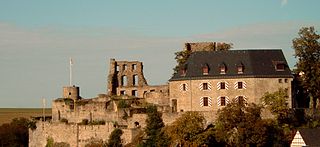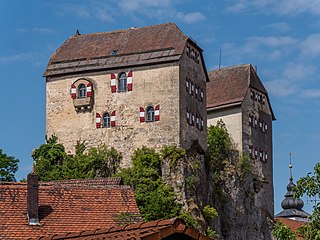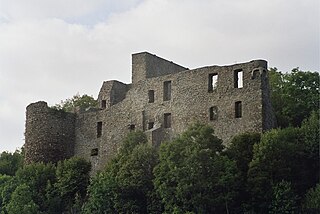Mayen-Koblenz is a district (Kreis) in the north of Rhineland-Palatinate, Germany. Neighboring districts are Ahrweiler, Neuwied, Westerwaldkreis, district-free Koblenz, Rhein-Lahn, Rhein-Hunsrück, Cochem-Zell, and Vulkaneifel.

Stahleck Castle is a 12th-century fortified castle in the Upper Middle Rhine Valley at Bacharach in Rhineland-Palatinate, Germany. It stands on a crag approximately 160 metres (520 ft) above sea level on the left bank of the river at the mouth of the Steeg valley, approximately 50 kilometres (31 mi) south of Koblenz, and offers a commanding view of the Lorelei valley. Its name means "impregnable castle on a crag", from the Middle High German words stahel (steel) and ecke. It has a water-filled partial moat, a rarity in Germany. Built on the orders of the Archbishop of Cologne, it was destroyed in the late 17th century but rebuilt in the 20th and is now a hostel.

Schloss Veldenz in the Hunsrück upland, on a steep vale draining into the Mosel is a castle ruin about 1.5 kilometres (0.9 mi) southeast of the village of Veldenz in the German state of Rhineland-Palatinate.

Kastellaun Castle is a ruined medieval castle in Kastellaun in the Rhein-Hunsrück district in Rhineland-Palatinate, Germany.

The Sporkenburg is a late medieval castle ruin about one kilometre south of Eitelborn in the district of Westerwaldkreis in the German state of Rhineland-Palatinate.

The Nürburg is a ruined hilltop castle in the German Eifel Mountains near the village of Nürburg south of Adenau in the district of Ahrweiler in the state of Rhineland-Palatinate. It stands within the famous North Loop, or Nordschleife, of the Nürburgring racing course at an altitude of 678 m (2,224 ft) on a volcanic basalt cone. It may be visited for a fee.

Gräfenstein Castle is a ruined rock castle about 2 kilometres (1.2 mi) east of the village of Merzalben in the German state of Rhineland-Palatinate. It is in the county of Südwestpfalz within the Palatine Forest and is often called Merzalber Schloss. It is built on a rock plateau 12 metres (39 ft) high at an elevation of 447 metres (1,467 ft) above sea level.

Altenstein Castle is a ruined castle in Altenstein in the district of Haßberge in Lower Franconia, Germany. The family seat of the lords of Stein zu Altenstein, which died out in the 19th century, is located 40 kilometres north of the city of Bamberg and, since the end of the 20th century, has been managed by the district of Haßberge. The castle was renovated around the turn of the millennium.

Grenzau Castle is a ruined spur castle at 250 m above sea level (NN) near Höhr-Grenzhausen in the county of Westerwaldkreis in the state of Rhineland-Palatinate. It is the only castle in Germany with a triangular bergfried.

Langenau Castle is an old lowland castle in the municipality of Obernhof in the county of Rhein-Lahn-Kreis in the German state of Rhineland-Palatinate.

Hohenfreyberg Castle, together with Eisenberg Castle directly opposite, forms a castle group in the southern Allgäu that is visible from a long way off. It is located about four kilometres north of Pfronten in the county of Ostallgäu. The late mediaeval hilltop castle was abandoned during the Thirty Years' War and set on fire. From 1995 to 2006 the former aristocratic seat was comprehensively made safe and conserved as part of a closely observed "example of renovation".

The ruins of the Thurant Castle stand on a wide slate hill spur above the villages of Alken on the Moselle in Germany. The castle is in the district of Mayen-Koblenz in Rhineland-Palatinate and belongs to the spur castle type. Vine gardens on the sunniest slope.

Hiltpoltstein Castle was originally a high mediaeval aristocratic castle dating to the 11th or 12th century. It stands in the centre of the market village of Markt Hiltpoltstein in the Upper Franconian county of Forchheim in the south German state of Bavaria. Its present appearance as a triple-winged building goes back to renovations carried out at the end of the 16th century.
Sayn was a small German county of the Holy Roman Empire which, during the Middle Ages, existed within what is today Rheinland-Pfalz in Germany.

Old Wolfstein Castle, is a ruined hillside castle on the eastern slopes of the Königsberg at the narrowest point in the Lauter valley near Wolfstein in the county of Kusel in the German state of Rhineland-Palatinate.

Schönecken Castle is a ruined hill castle at 467 m above sea level (NN) above the village of Schönecken in the Nims valley in the West Eifel mountains. It lies within the county of Bitburg-Prüm in the German state of Rhineland-Palatinate. The castle stands on the lowest hill ridge in the middle of a valley bowl. The site is guarded on all sides by higher hills.

Virneburg Castle is a ruined hill castle on a slate hill, 430 m above sea level (NHN), around which the Nitzbach stream flows. It stands above the village of Virneburg in the county of Mayen-Koblenz in the German state of Rhineland-Palatinate.

The Niederburg at Kobern, also called the Niedernburg, Unterburg or Neue Burg, is a hill castle above the municipality of Kobern-Gondorf in the county of Mayen-Koblenz in the German state of Rhineland-Palatinate.

The Oberburg at Kobern, also called the Oberburg or Altenburg, is a hill castle above the municipality of Kobern-Gondorf in the county of Mayen-Koblenz in the German state of Rhineland-Palatinate.

























